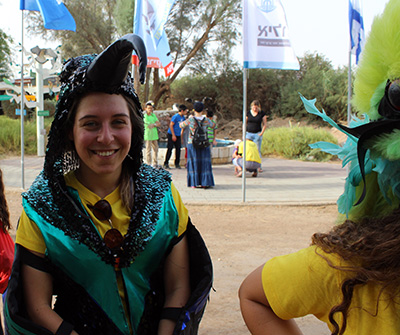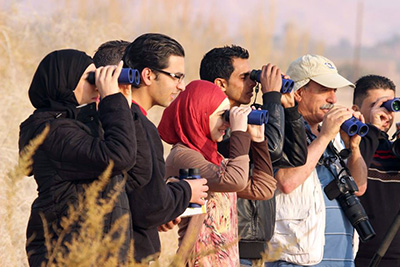
Master Plan for Important Bird Areas in Eilat and the Southern Arava
 The IBRCE team is working on a master plan that would improve the lives of migratory and residents birds. In the past, the stop-over sites (that we call refueling stations for birds) and the habitats of the local birds consisted of undisturbed natural areas, such as: salt marshes, Acacia groves, springs, and undisturbed beaches. Unfortunately, very few of those habitats remain, but those areas are protected by law. The sites that hold most of the migratory birds today, are actually man-made habitats, such as: sewage ponds, saltpans, fields, orchards and date plantations, and managed beaches. These habitats are good stop-over sites for birds, but only as a byproduct; they are managed for an entirely different cause such as profit or the efficiency or comfort of humans. Therefore they are entirely unprotected and don't necessarily fulfil all the needs of the birds that live there. Our goal is to create a dialogue with farmers, municipalities, industrialists, and even the army so these habitats will be managed in a way that will also serve the birds that live there.
The IBRCE team is working on a master plan that would improve the lives of migratory and residents birds. In the past, the stop-over sites (that we call refueling stations for birds) and the habitats of the local birds consisted of undisturbed natural areas, such as: salt marshes, Acacia groves, springs, and undisturbed beaches. Unfortunately, very few of those habitats remain, but those areas are protected by law. The sites that hold most of the migratory birds today, are actually man-made habitats, such as: sewage ponds, saltpans, fields, orchards and date plantations, and managed beaches. These habitats are good stop-over sites for birds, but only as a byproduct; they are managed for an entirely different cause such as profit or the efficiency or comfort of humans. Therefore they are entirely unprotected and don't necessarily fulfil all the needs of the birds that live there. Our goal is to create a dialogue with farmers, municipalities, industrialists, and even the army so these habitats will be managed in a way that will also serve the birds that live there.
How do we make this happen?
- Survey all habitats, natural or man-made during migration, the breeding season, and winter to record the diversity and abundance of birds that use the habitat.
- Map hazards and risks for the birds in these habitats, find possible mitigation measures, and recognize opportunities to optimize their services for the birds, as well as services provided by birds to the site.
- Contact the owner or operator of the infrastructure/habitat, explain how important it is for resident and migratory birds, and find simple ways to help reduce risks and optimize services for the birds together, including advocacy or finding funds to facilitate the needed changes.
A few examples:
- The saltpans of Eilat are a factory producing salt from seawater but at the same time also great foraging habitat for flamingos, waders, gulls, ducks, and passerines, and an important site for many other species to have a rest during the long migration. The salt factory "Salt of the Earth" was very cooperative with closing access to sensitive areas for breeding or migratory birds, removing obstacles for the birds, and even building bird blinds and watch points for birdwatchers.
- The “North Beach” used to be packed with seabirds, but looks worse than ever now. The seabirds have lost their quiet beach to the tourists; and the islands where they once bred in the Red Sea, Saudi Arabia, and Egypt are now under major development and construction. We noticed that the birds lacked perches above the water in the vicinity of their foraging areas, and Caspian and White-cheeked Terns started nesting in places that looked unfit, with a low success rates. We chose to approach the most active organization in the bay – the navy, and together we built perches and safe nesting platforms for the seabirds, and the navy patrols collect wounded seabirds they find on their travels.
- The springs of the southern Negev, which were important stop-over sites for migratory birds, and drinking spots for local desert birds, are losing their vitality due to the overuse of ground water. We have noticed sandgrouses, Trumpeter Finches, and other desert species drinking sewage water (a probable health risk). Also, small orchards originally made for soldiers, were packed with wildlife in the past. Together with the local army base, we reconstructed the orchard to reduce risks to the birds and to create more food sources, and we established clean watering spots for the desert birds that flock there in the hundreds.
- The sewage pond of Eilat attracts thousands of cormorants, ducks, herons, and gulls every year. Along the reed beds one can find an abundance of passerines, waders, rails, and herons. Once a year, the sewage company clears the reeds from the banks and leaves the birds "naked," out in the open. We have started to negotiate with the sewage factory to determine the best time of year for the clearing of the reeds, as well as constructing floating islands for the birds and building a watch point for birders on-site. We are still searching for funding of this project.
Research and Monitoring
 The IBRCE, in partnership with the SPNI, is conducting a large-scale monitoring program in Eilat and the southern Arava in order to learn the status of local birds and to census the bird population that passes through the area.
The IBRCE, in partnership with the SPNI, is conducting a large-scale monitoring program in Eilat and the southern Arava in order to learn the status of local birds and to census the bird population that passes through the area.
Our main surveys are:
- Physical condition of the migratory birds – ringing daily during the main migration seasons. We use a constant effort protocol and do not use audio-luring, to ensure the quality of the data gathered.
- Raptor migration counts in spring – Eilat hosts one of the busiest raptor flyways in the world with well over a million raptors every year, including most of the world’s population of the Levant Sparrowhawk and the endangered Steppe Eagle, and hundreds of thousands of Honey Buzzards and Steppe Buzzards. We keep 2 counting posts in the Eilat Mountains that work from sunrise to sunset, daily.
- Monitoring important stop-over sites in Eilat and the southern Arava.
- Rare breeders of the desert – larks, owls, and raptors (planned for 2017).
- Offshore monitoring of seabirds with the marine biologists from the Interuniversity Institute for Marine Sciences.
- In addition, we allow our ringing station to be used as a platform by other researchers to gather data, such as: DNA samples for genetic analysis, parasites, plumage studies, movement studies, etc…
Education and Eco-tourism
Spreading the word about nature conservation is one of our main goals. Therefore, we conduct the following programs:
- "What's Your Bird, Eilat" – an educational and "place making" project that wanted the people of Eilat to explore their uniqueness and at the same time connect them with the birds. All the schools of Eilat were involved, along with local media and businesses. The result was 15,769 votes, of which 5,670 went to the winner – the White-eyed Gull – the bird that never left Eilat. Read more about it here (you may have to scroll down).
- "Migration Madness – Eilat" is another educational program that ran for several years in 4 schools in town, which explains the life of migratory birds in Eilat and the role of its inhabitants in protecting them.
- "Champions of the Flyway" is an SPNI and BirdLife International project to create awareness and collect funds to battle the illegal killing of birds. The event is a 24 hour birders race to see as many species of birds as possible in the area of Eilat and southern Israel. Every year more than 40 teams, from around the globe, gather in Eilat to participate. Please check the COTF website.
Regional Cooperative Projects
 In many parts of the world, cross-border cooperation in nature conservation is a necessary task. Unfortunately, in the Middle East it is not easy, and every cross-border activity is something to be proud of. Most of our cross-border work is not published in order to protect our partners, who might be attacked by anti-normalization movements that are active even in countries that have full peace agreements with Israel. We can openly promote the following:
In many parts of the world, cross-border cooperation in nature conservation is a necessary task. Unfortunately, in the Middle East it is not easy, and every cross-border activity is something to be proud of. Most of our cross-border work is not published in order to protect our partners, who might be attacked by anti-normalization movements that are active even in countries that have full peace agreements with Israel. We can openly promote the following:
- Being part of an Israeli-Palestinian project, funded by the European Union and managed by the Hanns Seidel Foundation to promote nature conservation and eco-tourism capabilities in Palestine and to build a cross-border network of wildlife experts and eco-tourism operators from both countries. In the scope of this project, we trained future Palestinian experts and hosted exchange visits and courses.
- We are currently working on a program that will create a marine important bird area for seabirds on the marine border between Israel and Jordan, in the Gulf of Aqaba. The two countries’ navies will have a crucial role in building perches and nesting platforms, and protecting the birds in the area.